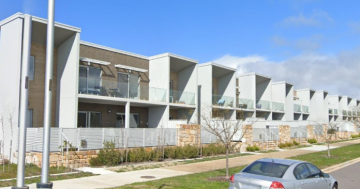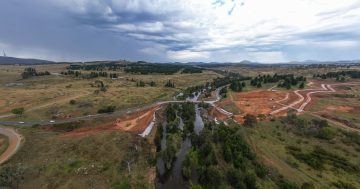
An early artist’s impression of the Molonglo Town Centre. Image: ACT Government.
Planning for Canberra’s first gas-free, all electric town centre is underway with a consultant hired to advise the Suburban Land Agency on building the suburb and how to help its occupants adapt their business operations to that environment.
The Molonglo Commercial Centre in the Molonglo Valley will be the heart of the emerging district and will accommodate commercial, retail, residential and community facilities.
The Labor Party promised to fast-track development of the centre during the 2020 ACT election campaign.
Molonglo Community Forum interim spokesperson Ryan Hemsley said the awarding of the $80,000 contract to Arup Australia was the first significant progress in a number of years towards a start on the town centre.
He said the first land release for the town centre is due in 2021-2022, and the community is looking to the ACT Budget later in 2021 for confirmation of this.
“We expect that timeline to be adhered to because anything further into the future is a clear-cut broken promise,” said Mr Hemsley.
But nothing can happen until the ACT Environment, Planning and Sustainable Development Directorate releases concept plans and a Territory Plan variation, which is expected mid-year.
“We can expect shops operating in the town centre sometime in the late 2020s, by which time Molonglo’s population will be larger than Weston Creek’s,” said Mr Hemsley.
“Any delays that happen now will have flow-on effects half a decade or more into the future.”
The move to a gas-free development is part of the Labor-Greens parliamentary agreement, and the project is seen as a model for the planned phase out of fossil fuels as part of the ACT’s bid to cut its greenhouse emissions from 1990 levels to zero by 2045.
While there will be no new connections to the natural gas mains network, the centre will have access to transitional arrangements such as tanks.

Map of where the Molonglo Town Centre will be located. Image: Supplied.
Arup Australia will look at the barriers and issues for businesses in a gas-free centre, such as the cost of commercial induction cooking, cultural preferences for gas cooking, and whether electric systems have enough capacity.
The ACT Government wants to know how to overcome these problems through innovation and possible financial incentives that may ease concerns and support adaptation, and how much these would cost upfront and into the future.
Arup Australia will identify typical uses in a commercial centre, including restaurants and cafes, shops and supermarkets, schools, offices and residences, and analyse ACT attitudes towards gas and electric services.
It will survey and consult with relevant stakeholders such as the Green Building Council of Australia; the Restaurant and Catering Industry Association of Australia; Canberra Institute of Technology’s catering school; local businesses; commercial suppliers; and building and plumbing organisations.
Arup Australia will also look at other similar sized centres in Australia and overseas that have gone down the gas-free route and how they were built and operate.
It will submit two interim reports to the ACT Government by 11 June and 25 June, and a final report by 30 July.





















